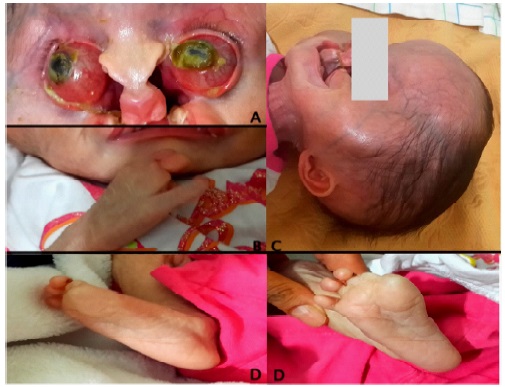
Journal of Clinical Images and Medical Case Reports
ISSN 2766-7820
Case Report - Open Access, Volume 2
Ablepharon: Report of a rare case
Moutei Hassan*; Bennis Ahmed; Chraibi Fouad; Abdellaoui Meriem; Idriss Andaloussi Benatiya
Ophthalmology Department, Hassan II University Hospital Center in Fez, Morocco.
*Corresponding Author : Moutei Hassan
Ophthalmology Department, Hassan II University Hospital Center in Fez, Morocco.
Email: mouteihassan@yahoo.fr
Received : Feb 11, 2021
Accepted : Mar 20, 2021
Published : Mar 22, 2021
Archived : www.jcimcr.org
Copyright : © Hassan M (2021).
Introduction
Ablepharon is a rare, congenital pathology, characterized by the absence of the eyelids. It can be isolated or constitute complex syndromes with significant local changes that can affect the face, bone, genital system and skin [1].
We report the clinical observation of a 3-day old newborn with the following history: unsupervised pregnancy, unmedicalized home delivery with poor adaptation to extrauterine life.
The ophthalmological examination found a bilateral Ablepharon, with an abscess on the entire cornea which interfered with the rest of the examination (Figure 1).
This newborn also presents many dysmorphic signs including: significant cephalic distension, bilateral labio-maxillo-palatal cleft, with oligodactyly involving the upper and lower limbs (Figure 1).
A radiological and biological assessment was requested, as well as a genetic study, but the child died as a result of severe respiratory distress.
In all cases, a complete ophthalmological examination should be performed, possibly combined with a radiological check-up including a computed tomography (CT) scan and magnetic resonance imaging (MRI), especially in the most complex syndromes.
The search for a family history with a genetic study is essential to confirm certain diagnoses and to authorise genetic counselling. [2].
Surgical reconstruction of the eyelids and bilateral penetrating keratoplasty is often necessary to protect the ocular surface and improve the functional prognosis. However, early amniotic membrane transplantation may be performed while awaiting definitive treatment.

Citation: Hassan M, Ahmed, Fouad C, Meriem A, Benatiya IA. Ablepharon: Report of a rare case. J Clin Images Med Case Rep. 2021; 2(2): 1031.
References
- Feinstein E, Traish AS, Aakalu V, Kassem IS. A case report of Ablepharon-Macrostomia syndrome with Amniotic membrane grafting. COP. 2015; 6(3): 366‑72.
- Jaloux C, Malet T, Duquennoy-Martinot V, Bardot J, Casanova D, Bertrand B, et al. La paupière malformative chez l’enfant. Annales de chirurgie plastique esthétique. 61(5): 462-479.
